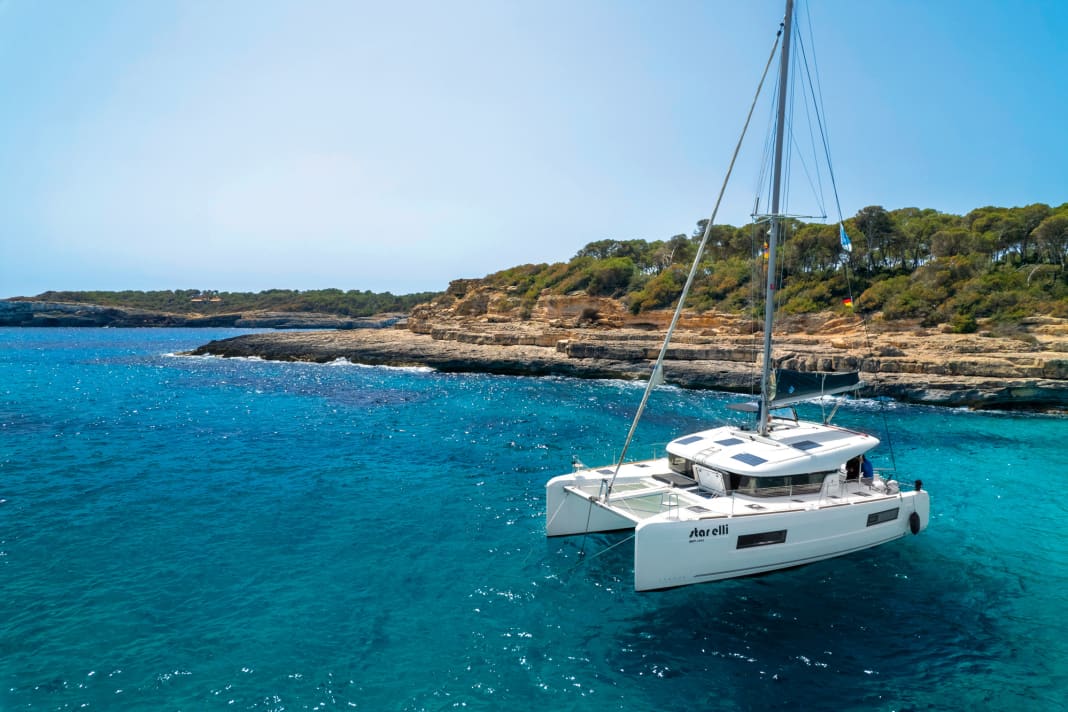





This article is part of a charter special. The contents:
Especially for skippers and crews who have never sailed a catamaran before, handling a multihull means rethinking many things: harbour manoeuvres, sail handling, reefing, anchoring - some things are more different on two hulls than some people think. Anyone who has to manoeuvre the cat through a narrow pit lane for the first time will notice this - the enormous width and the fast drifting in strong crosswinds demand foresight and caution.
Although many crews now have initial experience with catamarans, as they have been on the rise in charter fleets for years, this does not always mean that they are familiar with all the peculiarities of the boats and can master them safely in all weather conditions.
Many fleet operators report that the proportion of crews who sail the boat only a little and motor more and more has been growing steadily for years. This may also be due to the fact that the cat is well suited to newcomers who are looking for a holiday on the water rather than sailing fun, but it may also simply be due to a lack of knowledge about the subject. And not every skipper wants to take a skipper training course before going on holiday.
From our own editorial experience of many charter trips with catamarans from a wide variety of shipyards and discussions with base managers and cat owners, we have compiled 12 tips here that will help make your next catamaran charter trip a complete success - and increase the proportion of sailing.
The advantages of a catamaran charter ...
- Huge amount of space. A 40-foot cat offers as much space as a comparable 46- to 48-foot vessel
- Cooking, cockpit, navigation - all on one level, lots of light
- Less position and therefore less stowage before sailing
- Usually one complete bathroom per room
- Good manoeuvrability in port thanks to two engines
- Very simple and fast dinghy handling
- Little draught, therefore more choice of bays and harbours
- No rolling at anchor with a light wave
... and the disadvantages
- Significantly higher mooring fees in harbours and buoy fields compared to the monohull
- Less sporty sailing experience at the price of greater comfort
- Greater space requirement in the harbour and for manoeuvring
- Deposit amounts up to 50 per cent higher in some cases, resulting in more expensive deposit insurance
- Higher weekly charter price compared to a monohull with the same number of cabins
- Reefing time and taxes by numbers instead of feeling
1st harbour manoeuvre with the catamaran
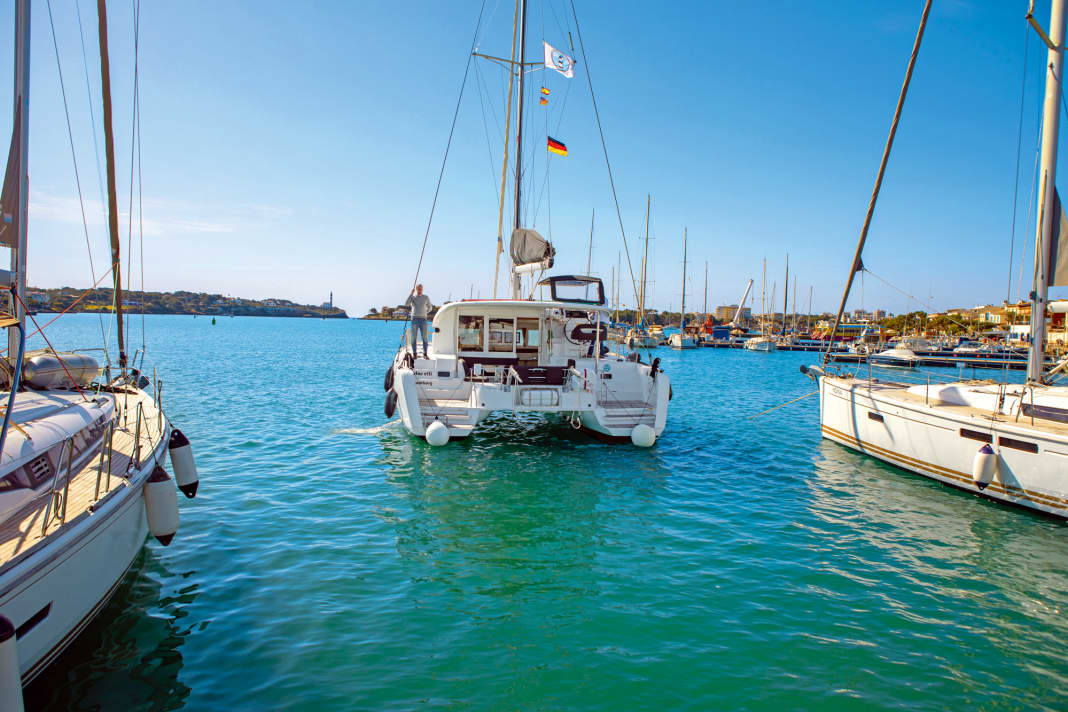




The sheer dimensions of the platform of some cats often make beginners in particular swallow. It is not always easy to manoeuvre this hulk out of and into Mediterranean harbours, some of which are too narrow. However, the cat has one major advantage: with the two engines, it can be turned on the plate like a tank: one engine forwards, the other backwards, and the boat turns on the spot.
Important: The last few metres backwards into the gap in particular are best done using only the engines, not the rudders. To do this, you can lock the blades in the midships position (caution: tighten the screws on the wheel firmly!) and then determine the speed and direction just by operating the throttle. The good thing is that if a crosswind pushes the boat unevenly to one side, you can easily straighten it at any time, even when travelling backwards. Kats are susceptible in this respect due to their small lateral surface. It often takes a bit of rethinking, especially when first casting off and mooring.
It is therefore best to practice a few turns and reverse approaches after casting off for the first time, perhaps in the harbour forebay or directly outside the harbour, where there is a little more space. Very important: The propellers of many new cats are aft of the rudder blade and often just under a metre from the stern! This makes it very easy to catch mooring lines. So take special care when turning the boat in and out of the gap!
When practising, the skipper also quickly realises whether he has blind spots in his view from the steering position. If there are any, position a crew member there when docking so that the helmsman can ask about obstacles and distances. And: Sometimes the engines do not run at the same rpm with the same lever position on the control panel.
More about catamaran harbour manoeuvres
2nd buoy manoeuvre with the catamaran
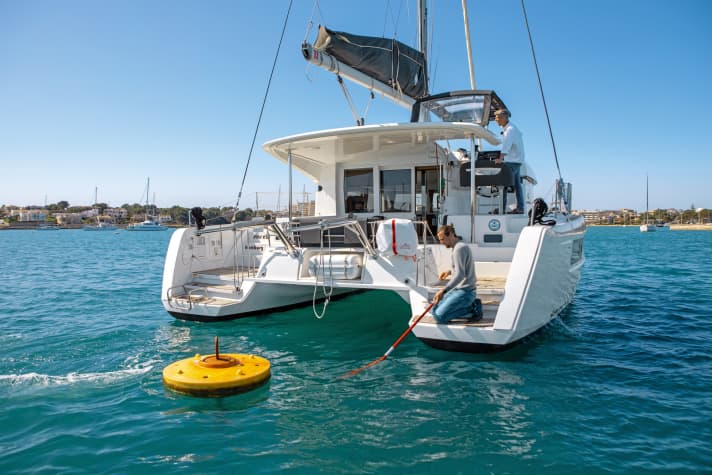
In more and more areas, especially Croatia, Italy and Spain, you can find buoy fields in bays. Anchoring is usually prohibited there. When cat crews approach the buoy, they often make it unnecessarily difficult for themselves and head for it with the bow. As catamarans are often difficult to see from the helm and the freeboard is much higher than on monos, crew members have problems picking up the buoy or the line, which is usually floating in the water next to it, and connecting their own to it.
Instead, it is better to sail backwards towards the buoy. There, the skipper can almost always see the distance himself without any problems, and the crew member with the line is at the same height as the buoy. Pull the line(s) through and then take it forwards along the side of the cat while the skipper turns the cat with the engines on the disc. Also moor to the buoy with a hahnepot, i.e. two lines on the cleats at the bow.
3. set sail on the catamaran
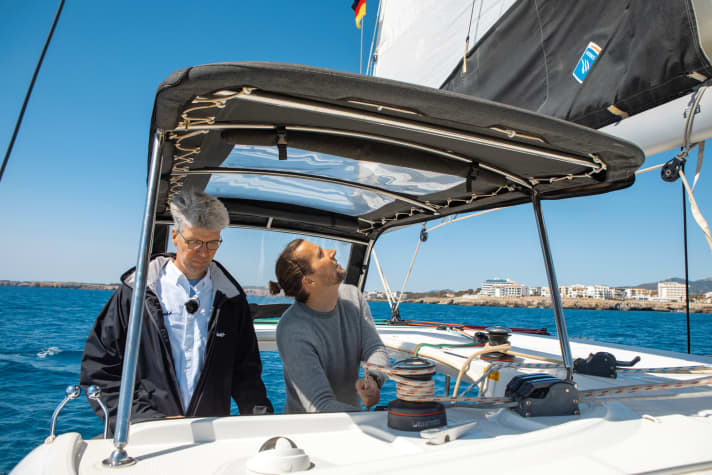
Since the mainsails of cats are often larger in area than monohull sails and are almost always fully battened on more or less high-quality slides, this is new for many crews who previously only travelled with furling mains on monohulls. Due to the high weight, the halyards are often even lowered again with a block. So there are either high loads on the winch and/or long distances to crank.
It is therefore not uncommon to have an electric winch with one fast and one slow gear on board. Use them with caution, because two problems often occur when setting the sails if they are used carelessly: The batten ends often get caught in the lazy-jack lines of the main, or a reef is forgotten to be taken out of the sail. The electric winch, which is very powerful in low gear, can then either tear the lazy-jack lines or damage the reefing thimbles in the sail, which is very expensive damage. So use the winch with care and caution.
4. under sail
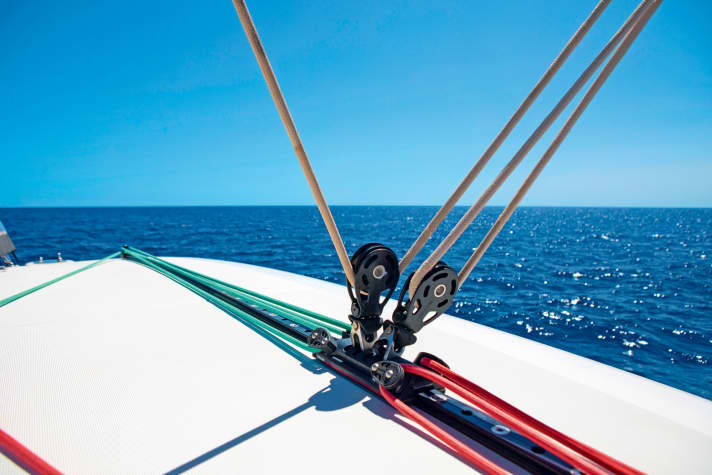
Kats are driven differently to monos. The mainsheet traveller, which usually runs across the entire width of the cabin roof, is a central trimming instrument. It is the preferred instrument in front of the mainsheet, especially for releasing pressure quickly. When jibing, it is particularly important to bring the traveller to the centre beforehand. Otherwise, if you jibe incorrectly or even jibe a jib, the traveller can take a really long swing and either slam into the stops or, in the worst case, the battens into the shrouds. If this happens, battens can even break.
Another mistake you often see: Crews want to tack, but have not sailed really high beforehand and have trimmed the sheets accordingly. With very little or a lot of wind, the boat can then starve in the tack. The only thing that helps then is to hold the genoa back briefly.
5. reef in good time

Kats have one disadvantage compared to the mono: if the wind gets stronger, it does not tell the skipper whether the boat is overpowered, i.e. whether it needs to be reefed, either by its position or by increasing rudder pressure. There are reefing tables in the operating instructions for this purpose.

Sometimes simple, based only on wind force, sometimes elaborate, which also take into account wind angle and even swell height for each wind speed. Inexperienced crews should stick to these.
Sometimes annoying: Some fleet operators have their own tables with wind speeds on board that are even lower. If you follow them, you will often experience a slow-sailing cat. In this case, you can alternatively take a look at the boatyard manuals of the boat (manufacturer's website), where you will sometimes find completely different tables. However, the problem with typical large-scale charter cats is almost never the wind pressure alone, which very rarely leads to capsizing. It is usually the combination with high swell that is difficult.
6 Anchoring safely with the catamaran
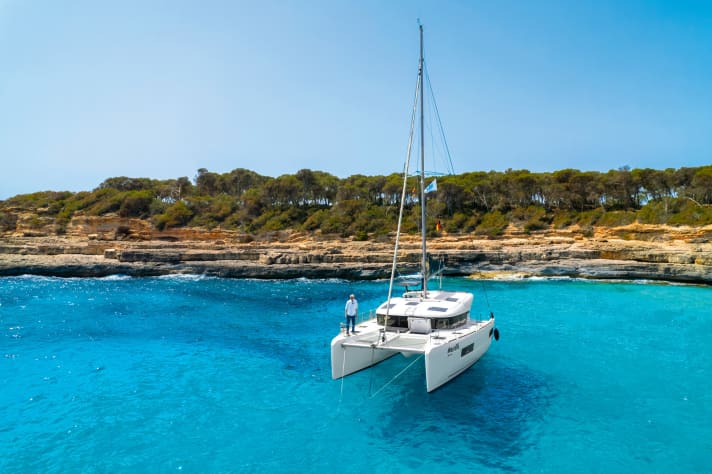
Catamarans sway much more at anchor than monos due to their high superstructure and small lateral plan in the water. In order to reduce this, there is practically always a ropeshackle pot attached to the beams, which is hooked into the chain with a shackle. So: Lay enough chain for the water depth, then attach a shackle to the chain in front of the bow roller and slacken it so far that there is no more tension on it up to the shackle. The boat will then lie much more calmly. Nevertheless, when anchoring with the catamaran, allow more room for manoeuvring in narrow bays than with the monohull. If space is tight, a shore line can be deployed as an alternative.
7. dinghy handling
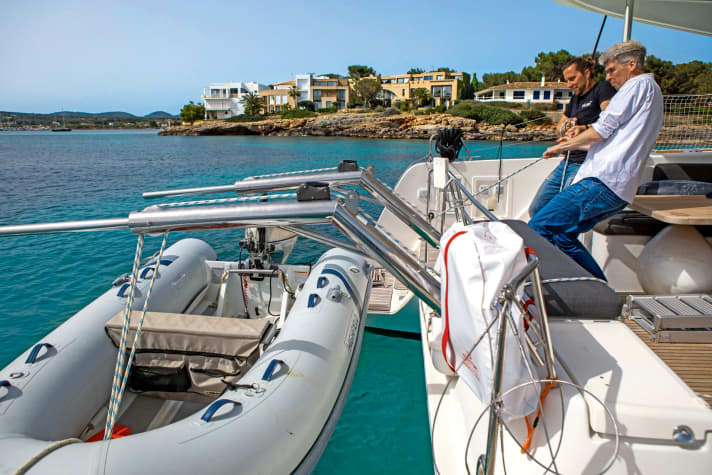
Handling the dinghy with the two davits is much simpler than on the monohull, but there are still things you can do wrong. It is important to note that the boat sometimes hangs very loosely in the davits when it is pulled up to the top. Then the beads often rub against the davits or the stern in rough seas. Therefore, secure the dinghy properly with lines. Secure the tank and paddle, close the tank vent screw.
If the cat has less freeboard, it may be necessary to fold the engine up, otherwise it will enter the waves in rough seas. Important: Some catamarans have very short sterns; if the dinghy is hanging in the davits, it can touch the dock on high concrete piers in harbours before the boat is close enough to the pier for the gangway. Sometimes the dinghy has to be taken out of the davits and placed between the hulls floating at the front.
8. mooring and casting off sideways with the catamaran
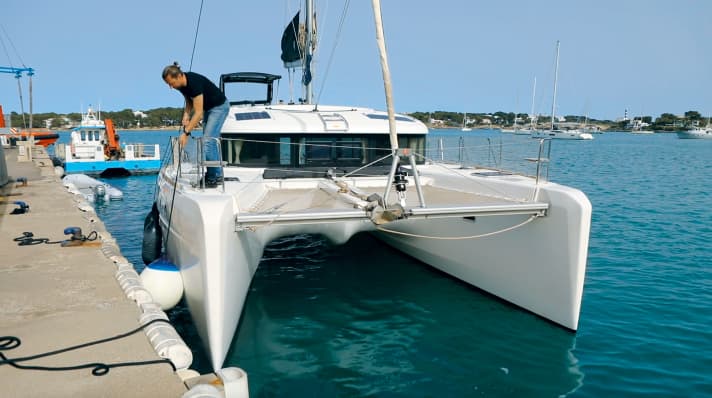
One advantage of the catamaran is that you can also turn the boat at the pier with the two engines. If you are alongside and the wind is blowing onshore, the only thing that helps with a monohull is steaming into a spring. With the multihull, both engines simply do it. One forwards, one backwards, and the cat starts to turn away from the pier. It's important not to forget to keep good fenders fore and aft, depending on the direction of rotation!
9. mooring crosswise
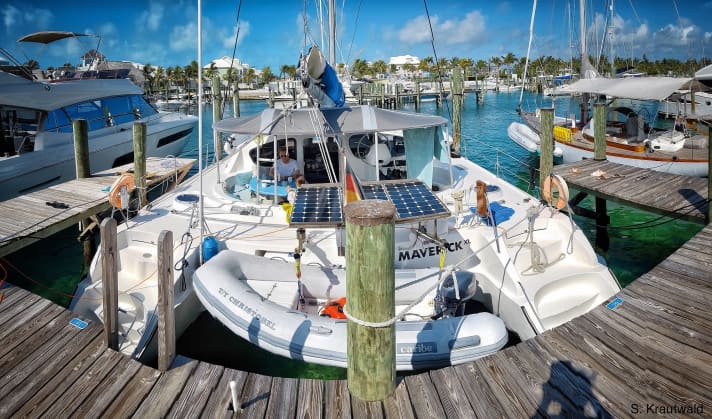
As cats are sensitive to wind, if there is a lot of crosswind or swell in the marina or harbour, the boat may lie unsteadily and the leeward stern may be pressed quite close to the pier due to the large width of the boat. This can be avoided relatively easily by tying the stern lines crosswise ashore in such weather. The angle of pull is much more favourable and the ship lies much more calmly as a result. Just make sure that the lines do not become a tripping hazard for the gangway or snag on the dinghy and its davits.
10. do not underestimate the swell
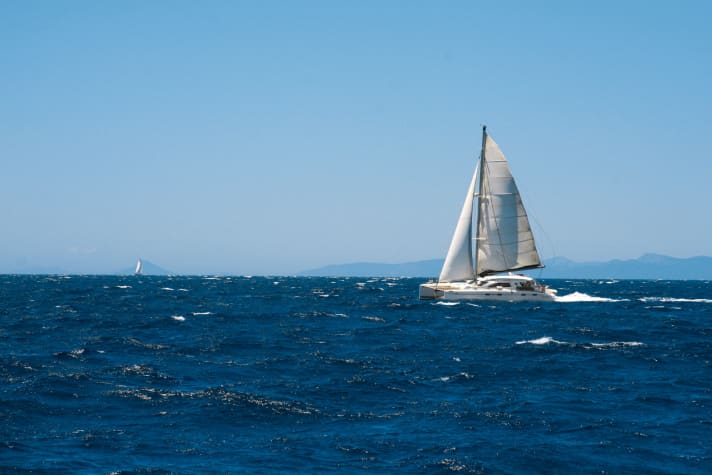
Some crews believe that because it sails upright, fellow sailors on a catamaran don't get seasick so quickly. That's not true, because multihulls move very differently in waves than monohulls: their enormous width means they are very stable. And with more waves, there are two hulls in the swell, not always in the same wave.
Basically, the cat performs faster, short righting movements that make some people more seasick than monos. And: When the boat goes through a wave, many people underestimate that once it has passed the first hull, it will hit the second hull with a very short delay. This leads to two boat movements and sometimes waves that hit hard under the cockpit floor. This can throw inexperienced people off balance.
11. environmentally friendly engines
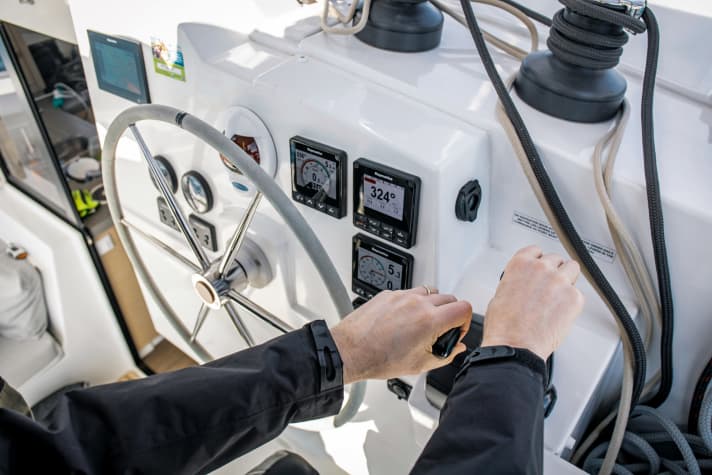
If you are travelling on a catamaran for a longer period of time with the engine running, it is much more environmentally friendly to only run one engine. This is because once the cat has picked up speed, i.e. after leaving the harbour or bay, it no longer pulls so strongly to one side if only one engine is running. This trick is widely used by cat owners, as it also saves fuel and extends the maintenance intervals. However, this tactic has hardly got around among charter customers so far. Why not give it a try, but please don't do it when manoeuvring in harbours or entering a bay!
12. safely onto the cabin roof

You have to climb onto the cabin roof to open the lazy bag, attach the halyard, clear the reefing lines and fold up the main. To do this, it is necessary to climb from the deck onto the roof. This is usually easiest from the front, as it is lowest there. Not all catamarans have fixed steps for this. These are usually also located at the front of the mast base and only rarely at the side. If there is a heavy swell and it is wet, the deck is not an ideal place to work due to the lack of holding options and sometimes slippery surfaces, for example due to glued-on solar panels.
Very important: If a crew member has to go up to the roof, the mainsheet traveller must not have any slack so that he cannot scythe across the deck, which can quickly happen with the endlessly long traveller paths ( see tip 4 ). The helmsman can also announce larger waves to crew members so that they know in good time when they should hold on.

